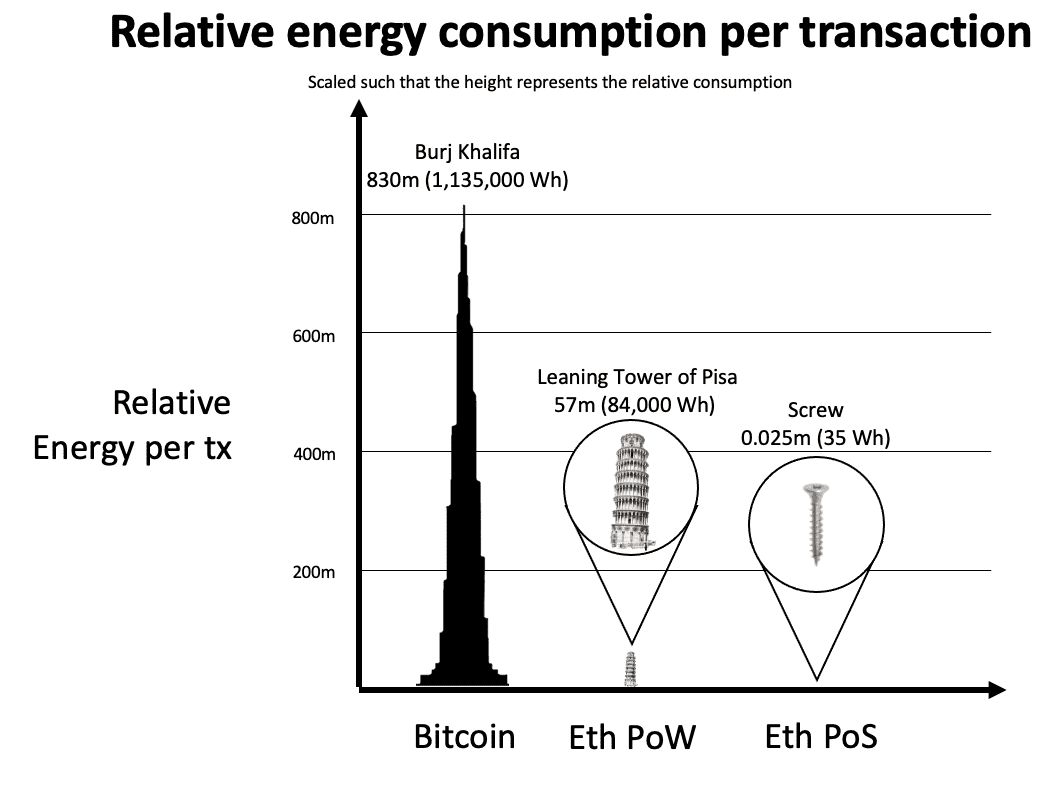Thanks to the proof of stake (PoS) consensus mechanism, a greener future is on the horizon for Ethereum, which will make the efficiency of the network two thousand times more.
A report by the Ethereum Foundation noted:
“With proof-of-stake being aorund 2000 times more efficient than proof-of-work, the energy expenditure of Ethereum will be roughly equal to the cost of running a home computer for each node on the network.”
The Ethereum Foundation also acknowledged that the PoS framework would trigger a 99.95% reduction in total energy use.

The Ethereum network uses a proof-of-work (PoW) system where miners solve a computational puzzle to validate a block.
Nevertheless, for the PoS consensus mechanism, validation of blocks is dependent on the amount of ETH staked because it is used as collateral against dishonest behaviour. Furthermore, validators will be required to have 51% of the total ETH staked running in the network to maintain a fraudulent blockchain.
The Ethereum Foundation stated that a transition to the proof of stake from the present proof of work is expected to happen in the second quarter of 2022. However, the Ethereum 2.0 deposit contract launched in December 2020 shows the viability of the PoS consensus mechanism.
Meanwhile, the proof of stake framework has gained steam in 2021 based on some of the advantages it presents, like cost-effectiveness and environmentally friendliness.
As a result, PoS networks like Solana, Polkadot, and Cardano are opening opportunities for staking-as-a-service (STaaS) providers.
With staking involving locking up crypto assets for a certain period of time to earn interest or rewards, this market is experiencing significant growth. For instance, Solana recently emerged as the most staked crypto with a value of $78.49 billion.
Image source: Shutterstock
Credit: Source link















 Bitcoin
Bitcoin  Ethereum
Ethereum  Tether
Tether  Solana
Solana  XRP
XRP  Dogecoin
Dogecoin  USDC
USDC  Cardano
Cardano  Lido Staked Ether
Lido Staked Ether  TRON
TRON  Avalanche
Avalanche  Stellar
Stellar  Toncoin
Toncoin  Shiba Inu
Shiba Inu  Wrapped stETH
Wrapped stETH  Wrapped Bitcoin
Wrapped Bitcoin  Polkadot
Polkadot  Chainlink
Chainlink  Bitcoin Cash
Bitcoin Cash  WETH
WETH  Sui
Sui  NEAR Protocol
NEAR Protocol  Pepe
Pepe  LEO Token
LEO Token  Litecoin
Litecoin  Aptos
Aptos  Uniswap
Uniswap  Wrapped eETH
Wrapped eETH  Hedera
Hedera  Internet Computer
Internet Computer  USDS
USDS  Cronos
Cronos  POL (ex-MATIC)
POL (ex-MATIC)  Ethereum Classic
Ethereum Classic  Render
Render  Artificial Superintelligence Alliance
Artificial Superintelligence Alliance  Bittensor
Bittensor  Ethena USDe
Ethena USDe  WhiteBIT Coin
WhiteBIT Coin  Arbitrum
Arbitrum  Dai
Dai  Bonk
Bonk  Stacks
Stacks  Filecoin
Filecoin  OKB
OKB  Cosmos Hub
Cosmos Hub  MANTRA
MANTRA